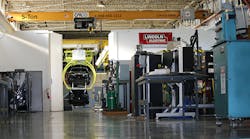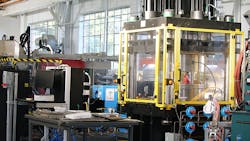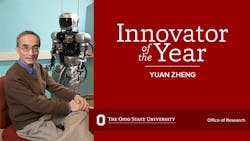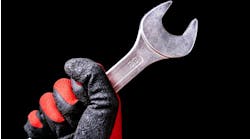COLUMBUS, Ohio — The Associated Press released its first college football poll back in October 1936, and during the more than eight decades since, no team has spent more weeks atop that esteemed if imperfect list than the Ohio State Buckeyes. Theirs is a dynasty that stretches across decades.
But where might the Buckeyes rank if The AP published a poll of, say, the top engineering schools from coast to coast? Well, U.S. News & World Report regularly publishes a similar (and admittedly more scientific) list whose most recent edition featured MIT, Stanford and Berkeley in the top three spots for both undergraduate and graduate programs. The Buckeyes? They ranked No. 28 and No. 31, respectively. Good, not great.
A new program situated almost literally in the shadow of Ohio Stadium could help improve those rankings — and turn Columbus into a destination for the next generation of manufacturing leaders.
About to kick off its third year, the Center for Design and Manufacturing Excellence (CDME) is not like other programs — either on the Ohio State campus or at most colleges in general. Students are hired employees, for starters, working as many as 16 hours per week during the academic year, and they aren’t pursuing a major, or even a minor: They’re all there for real, practical, experiential learning. They all work on real projects for real manufacturers. Some might even receive a patent. (One student has already done just that.) And the folks guiding them aren’t professors or assistants. Every one of them is either an active engineer or a former manufacturing executive or decision maker.
“That mentorship and experience you get from people that are in industry, that can spend the time to work with you, that’s what we’re trying to give the students here,” said John Bair, who started as an engineering student at Ohio State in 1985, founded Pinnacle Data Systems Inc. as a junior, then built it into a player in the medical and defense industries until selling it for $22.5 million and walking away three years ago.
Bair retired, he said, because he “was tired.” A quarter of a century as CEO, COO and CTO can do that. The opportunity, though, to give back to his alma mater by using those same skills to build up CDME and play some role in developing industry leaders — including two of his five sons, rising junior Tyler and incoming freshman David — was enough to lure him out of his respite.
Humble Beginnings, Lofty Goals
CDME was established to meet more needs for Ohio State’s external partners. Manufacturing, after all, accounts for more than one-sixth of Ohio’s half-trillion dollar GDP. Plus there are those 3.4 million or so manufacturing jobs projected to open up within the next decade. Why not open the door for manufacturers of all sizes to research and develop, and in the process provide an opportunity for teens and 20somethings to do the kind of work that will not just prepare them for the real world but push them right into it?
“Rather than working at UPS,” Bair said, the two dozen students who are a part of the program today “are working here. … We’re looking for self-motivated kids that are curious, that are basically self-aware. They know what they don’t know and are willing to learn anything. They all found the door.”
That, in itself, is an impressive feat. CDME shares a building with the Aquatic Ecology Laboratory that perhaps still had some new sheen when Woody Hayes arrived on campus … in 1951. The front door is around back. The interior is a maze of renovation. Donated equipment from Fanuc, Lincoln Electric and numerous other major manufacturers — all of them “coming in,” Bair said, “because they want to participate with the students” — will be on display and put to use starting with the grand opening of the new machine shop and innovation center scheduled for August 28.
Those donations have helped CDME speed up its development. So have two key chunks of money. The first was a $6.8 million federal grant from the Economic Development Administration. “If we wouldn’t have gotten that, we would have been probably two or three years away from where we are now,” Bair said. “That’s substantial. We would have been nickel-and-diming to get it going.” Bair credits Nate Ames, associate director and engineering manager for the CDME, and professor chief technologist Glenn Daehn in sparking initial interest from the EDA.
The EDA, in turn, seems to think it made a good call: “You have large manufacturers, medium-sized businesses, small business startups that are all coming together to collaborate at this facility,” said Dennis Alvord, deputy assistant secretary for regional affairs for the U.S. Department of Commerce.
“Those types of cross-pollinations could potentially create opportunities so those small business can take advantage of the collaborations with the larger businesses — maybe it becomes part of their supply chain, hopefully it accelerates their development and creates some of those future jobs.”
The second chunk was a seven-figure donation from an anonymous engineering alumnus who suggested Bair and the rest of the CDME team build it into a formal program for students from any background. The center is designed to grow to 160 students, which Eric Wagner, senior program collaboration officer for CDME and another former industry pro describes as a “sustainable business model.” (There has, however, been talk that that same donor will come back before the end of the planned three-year period with instructions to “build a big program.” It could develop into a minor, perhaps a major. “But for now, it’s an experiential learning program.”)
That allowed CDEM to log “$5.1 million in research and $1.5 million in commercial projects last year” Bair said. “A major help.”
Churning Out Quality Results
How strong a product can college kids — even college kids mentored by folks who ran companies with hundreds of millions of dollars in annual revenues — really offer? Maybe not the best damn product in the land, but close. Just listen to Wagner, who came to CDME in 2014 after a dozen years with DSCI, an aerospace and defense commercialization startup.
Three years ago, he said, right around the time CDME developed from an idea to reality, an electrical and computer engineering professor named Yuan Zheng developed a Circular Wave Drive, “a new gearing system to replace robotic gears. The speed reducers in humanoid robotics allow you to do very fine finger movement, very fast finger movement.” The market was healthy, but without any innovation for almost 50 years. A local venture capital company called IVOKE licensed the tech from Zheng and Ohio State, founded a startup called CWD LLC, then approached CDEM with the design and the patent and asked what they could do.
“We said, ‘Sure, how much did you raise?’ ‘Well, we raised $150,000.’ ‘How much do you have left?’ ‘We have $26,312 left. What can you help us out with?’” Just $26,312. Think about that.
“We said, ‘Listen, guys, this was going to be a much more expensive manufacturing project, but you are a central Ohio manufacturer, we’re supposed to leverage state and federal financing, and it’s a cool project. You’re not going to get it in two or three months, like we would want to get it to you, you’ll get it when we have time.’ We stretched it out over seven months and $26,312, and we got it done. We built an alpha and a beta prototype for that harmonic gearing system, which is part of a $900 million market, dominated primarily by one player.”
The goal was to cause that one player enough stress that they would either license the new product or buy the company outright — or they would disrupt the market. “That was the whole play,” Wagner said. “Along the way, though, we had a student inventor and our engineering manager come up with a new improvement on top of that that allowed it to be opened up for the RV50C gear replacement” which is used in major industrial robots.
For $26,312, CDEM translated the entire concept into a manufacturing design package, introduced CWD to the law firm that filed additional intellectual property on the improvement, and the undergrad who played a key role actually received a patent — reportedly the first time in Ohio State’s history an undergrad received a royalty on a patent. “Based off that, the state gave us a grant to go manufacture five different variants of it for five different commercial applications.” Fanuc, Magna Seating, Parker-Hannafin and Yaskawa Motoman were among those interested in the IP.
A Grand Opening … and a Grand Future?
Before the doors even opened, CDME leadership examined different models for academic research center. MIT Lincoln Laboratory provided inspiration. So did the Georgia Tech Research Institute. For now, at least, the goal is to emulate SRI International, originally called Stanford Research Institute. One key difference: The Menlo Park center is a 501(c)(3) nonprofit. CDME has no plans to leave the cover of the Ohio State umbrella.
“We want the students, we want the federal and state dollars on top of our clients’ dollars,” Wagner said. The support and the infrastructure are a key. “We do have to deal with the bureaucracy of the university. It’s a tradeoff, and so far, we think we’re doing a pretty good job of it.”
For now, the first program in Ohio State history to be run not by academics but by business leaders is “realizing what we are and what we aren’t,” Wagner said. “A lot of university programs and even federal programs fall down because they pretend to be something they’re not. We’ll never replicate Honda’s or GE’s research capability. We don’t want to. But, boy, we can help shepherd innovation into their process. And for the small and medium guys, we can be everything for them.
“If we can enable them and they become a $15 million manufacturer, where do you think they’re coming to do their research?
Wagner and other Center leaders sometimes refer to CDME as the “Center for Second Careers” — Bair, Wagner, Ames, Daehn and others all came to the center after retiring or stepping away after decades in industry — and the fun they’re having is obvious.
“When I was starting my business, it was like, ‘Boy, I wish we had those CAD tools. I wish we had this equipment,’” Bair said. “And the students! People literally underestimate them, they underestimate their ability. These kids can learn things so fast nowadays, it’s amazing.” Because without smart students, what’s the point of it all?






